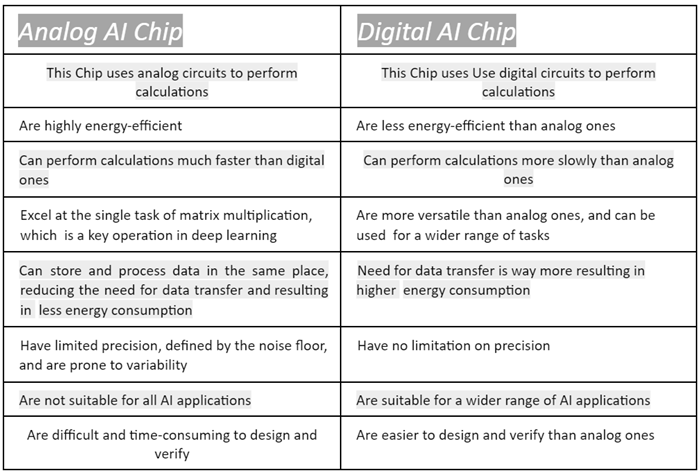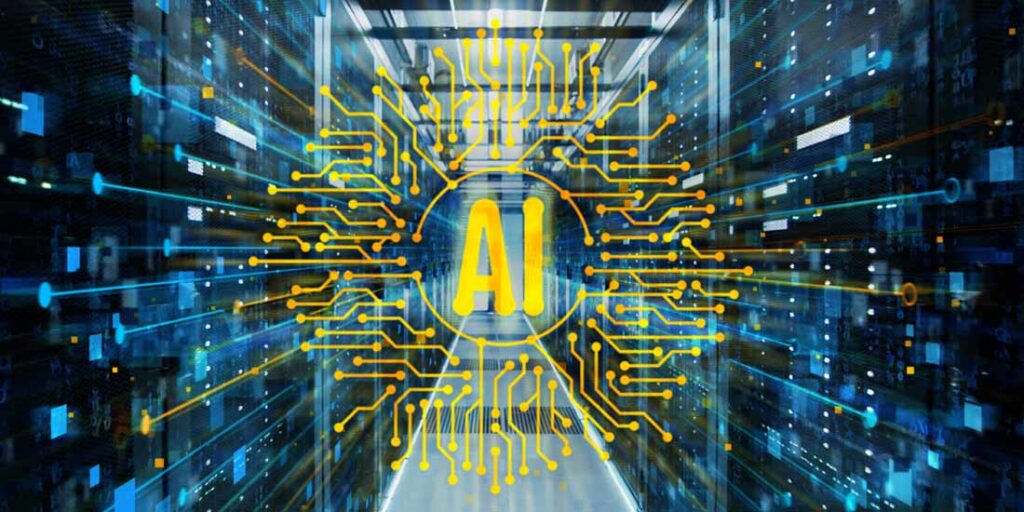Introduction
The biggest technological leap that we have made in this decade is Artificial intelligence (AI). These AI tools are rapidly transforming the world as we know it today. But currently It’s widespread adoption is limited by the high energy consumption and cost of traditional digital AI chips. To address this issue IBM have made a ground breaking advancement for AI, IBM has unveiled a cutting edge analog AI chip that promises and has potential to redefine the landscape of deep neural networks (DNNs). This chip is 100 times more energy-efficient and up to 10 times faster than traditional digital AI chips for performing deep neural network (DNN) computations.
What is IBM analog AI chip?
A traditional digital AI chip differ from analog AI chip in the way both of them process data. A digital AI chip use binary bit (0s and 1s) to represent data and preform calculations. However, analog AI chip uses continuous electrical signals to represent data and perform calculations. This way it allows analog AI chip to process much more efficiently that digital AI chip, especially for complex computations such as used in DNNs
IBMs analog AI chip uses variety of modern techniquesto improve the efficiency and accuracy. At the center of these technique is a transformative technology phase change memory (PCM). PCM is a type of non volatile memory that can retain data even when the power is turned off. This an approach for encoding network weights directly onto the chip, resulting in high speed and energy efficiency. This storage is typically very large and need to be accessed very quickly during computation. Another notable technique they have used is time-based analog-to-digital converters (ADCs). Time-based ADCs are very efficient at converting the continuous electrical signals used to represent data in analog AI chips to digital signals.
This new chip comprises of 64 analog in-memory compute cores, a monumental stride in the analog AI solution, thus removing the burden of data transfer requirements as seen in traditional system by executing
computation directly within memory. This chip is really good at handling computer vision AI tasks like recognizing thing in pictures, in comparison with its counter digital AI chip all the while conserving more energy. Also, it’s good at understanding natural language (human language) AI tasks but uses less energy almost 14 times less energy.

With introduction this chip the future where we can use energy efficient AI is no longer a distant dream. IBMs analog AI chip is still in the early stages of development but has the potential to completely change the way we use AI making it more efficient and affordable. IBM research is also working towards integrating both streams into one chip creating analog mixed signal chip for future. This chip could be used in developing new AI powered applications in many fields, such as healthcare, finance, education, transportation. Although, this will play a major significance in the AI systems there is lot of ground work to complete before we witness these integrations into customer market.
How IBM’s Analog AI Chip works
IBM’s analog AI chip make use of various techniques to improve its efficiency and accuracy for performing DNN (deep neural network) computations.
Some of the key techniques used by this chip:
- Phase Change Memory (PCM): With this techniques memory can retain data even when power is turned off, PCM is a type of non-volatile memory. This makes it ideal for storing the weights of a DNN, which are typically very large and need to be accessed quickly during computation. When PCM is heated, it can switch between two different states, amorphous and crystalline. The amorphous state has a high electrical resistance, while the crystalline state has a low electrical resistance. By applying different voltages to PCM devices, analog AI chip can store different values for the weights of a DNN.
- Time-based analog-to-digital converters (ADC): ADCs are used to convert continuous electrical signals into digital signals. Time-based ADCs work by measuring the time it takes for a voltage to rise or fall. This makes them very efficient for converting the continuous electrical signals used to represent data in analog AI chips to digital signals.
- Mixed-signal circuits: These are circuits that can process both analog and digital signals. IBM’s analog AI chip uses mixed-signal circuits to perform complex computations on the continuous electrical signals used to represent data in the chip.
The combination of PCM, time-based ADCs, and mixed-signal circuits allows IBM’s analog AI chip to perform DNN computations much more efficiently and accurately than traditional digital AI chips.
Advantages of using an analog AI chip over digital AI chip
- Energy Efficiency: Analog Ai chips are much more energy efficient when comparing with digital AI chip. This is because analog clip can perform calculations directly within their own memory, which reduces the need for data transfer hence resulting in less energy consumptions. Some sources even claim that these chips can be tens to hundreds of time more efficient.
- Speed: These new chip can perform calculations much faster that digital once. This is because analog chips use a range of information stored in a single transistor or memory cell, which allows them to store much more data in a smaller space.
- Scalability: Analog chip can be put on small device, like those used in the Internet of things (IoT), where power and heat are a big deal. This make these chip great for use like smart device or other small applications.
- Accuracy: Analog AI chip can be just as good as digital once for task like recognizing things in picture (computer version) and understanding and using natural language (Human language). Also, they use lot less energy.
- Cost: These new chip can be less expensive produce comparing to digital AI chip, as these chip require fewer transistors and other components.
Although there are some limitations to analogues computing, such as slight variance in result and single purpose focus, there are not major concerns for AI. Analog AI chip specialize in matrix multiplication, which is key deep learning, and can be used in conjunction with digital circuits to ensure minimal error. With this in mind overall the analog AI chip offers promising future for AI technology, with potential to significantly improve the efficiency of AI algorithm and change the landscape of AI world.
Difference between Analog AI Chip & Digital AI Chip

Impact of IBM’s Analog AI Chip
This analog chip holds lot of potential & promises to change the way we are using AI
- Accessibility and affordability: As this chip is more energy efficient, works are very high speed and the cost advantages open the way for making AI more affordable and accessible for business and individuals of all sizes. This could mean there might be a new wave of more innovations in many industries, as companies and individuals can deploy more AI solutions.
- Generative AI: Analog chips works faster this will help with generative AI where processing speed is of the essence. This a type of AI that can generate new content such as image, music or text. With the innovation of Analog AI chip there might be more potential new application in generative AI like music, art etc.
- Healthcare: AI powered medical diagnostic tools could use this chip to analyses medical image like X-ray or MRI more quickly and accurately. This will help doctors for better and accurate diagnostics and further treatment for patients. Also, the computation being very fast they can be used to develop new drug discovery by running more complex simulation this will help in making drugs/ medicines more cost effective.
- Data Analytics: These analog AI chips can be used to analyses large number of data sets together and come to conclusions. This will also help business make more informed decisions on complex data sets
There are endless possibility for innovation and advancement in AI with the analog AI chip
Conclusion
Although the chip is at its very early stages and IBM are working towards making it perfect. But the introduction of this analog AI chip that is much faster, efficient and cost effective they has opened the doors for innovation in the field of AI. This chip can holds the potential to disrupt many industries on how they have been using AI till now to how they can integrate AI into their business for much faster and better results.
We are excited to see what the future holds for IBM’s analog AI chip and many new and innovative AI applications that will enable.
About the Author

Justin Varghise is a dedicated blog writer with a passion for artificial intelligence. He focuses on the exciting field of AI and shares his insights through his website, aiphablogs.com. As an AI enthusiast, Justin explores the ever-evolving world of AI, diving deep into emerging AI tools, the latest trends, and breaking news in the field. In his articles he also explains how various industries leverage AI to innovate and enhance their operations. He’s also keen on discussing the practical AI tools that help business owners to streamline their operations, boost efficiency, and achieve a higher ROI.
Sign up for the free insideBIGDATA newsletter.
Join us on Twitter: https://twitter.com/InsideBigData1
Join us on LinkedIn: https://www.linkedin.com/company/insidebigdata/
Join us on Facebook: https://www.facebook.com/insideBIGDATANOW





Speak Your Mind